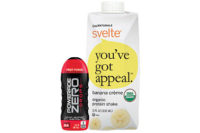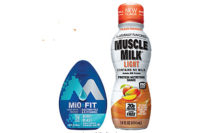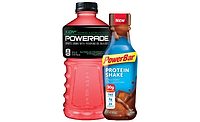Last year offered the sports and protein drinks category a big marketing opportunity through the London 2012 Summer Olympics, says Jennifer Zegler, beverage
| Jump to: |
analyst at Chicago-based market research firm Mintel. Atlanta-based The Coca-Cola Co.’s Powerade brand enhanced its brand awareness as the official sports drink of the London 2012 games, she points out. The brand hydrated more than 10,000 athletes across 26 sports on the field of play both in training and in game venues and also hosted the Powerade Hydration Center at the Olympic Athletes’ Village to allow athletes to customize their own Powerade sports bottles, order the Powerade Pro Sports Hydration powder, and receive hydration tips to help them perform, the company says.
In conjunction with the event, the brand launched its “Power Through” integrated marketing campaign in 35 markets. The campaign’s commercials urged athletes of any level to push through their performance to achieve their goals.
Although it was not an official sponsor of the London 2012 Olympic Games, Purchase, N.Y.-based PepsiCo’s Gatorade brand also gained brand awareness from the event, Zegler says. After the Olympics, Gatorade released its “What’s Inside” campaign, which featured Olympic sprinting champion Usain Bolt of Trelawny, Jamaica, and noted its presence at the events inside the bodies of the competing athletes, she explains.
Both Gatorade and Powerade brands were ranked as top-performing non-aseptic sports drinks for the 52 weeks ending Feb. 24 in U.S. supermarkets, drug stores, mass market retailers, gas and convenience stores, military commissaries, and select club and dollar retail chains, according to data from Chicago-based Information Resources Inc. (IRI). Gatorade Perform topped the chart at more than $2.7 billion in sales, followed by Powerade Ion4 at more than $882 million, according to IRI data. Overall, the non-aseptic sports drinks market increased approximately 5.5 percent to more than $5.5 billion, compared with the prior-year time frame, the market research firm reports.
Mintel estimates that the entire sports drink market grew 21 percent from 2007 to 2012 to reach approximately $6.3 billion in sales. It also predicts that the sports drink market will grow by 52 percent from 2013 to 2017.
Overall, Gatorade claims approximately 75 percent of the sports drink market, while Powerade holds on to just more than 20 percent of the market, says Jonas Feliciano, beverage industry analyst for Chicago-based Euromonitor International. Private label products make up another 1 percent of the category, while other sports drink brands make up the remaining 4 percent, he adds.
Building a new team
Sports drinks are traditionally intended for giving consumers quick electrolyte replenishment, notes Agata Kaczanowska, beverage industry analyst for Santa Monica, Calif.-based IBISWorld. For example, Powerade’s Ion4 advanced electrolyte system helps replenish four electrolytes lost in sweat, the company says. However, in the last few years, sports drink lines have expanded to offer even more benefits, experts note.
In 2010 and 2011, Gatorade launched G Series, G Series Pro and G Series Natural lines, each featuring different beverages for before, during and after activity, including protein drink options. For example, the Prime tiers within the G Series and G Series Pro lines offer carbohydrates to power muscles before activity; the G Series Natural series and Perform tiers of G Series and G Series Pro offer hydration during activity; and the Recover segment in the G Series line offers hydration, protein and carbohydrates to help muscles recover after activity.
In addition to this variety of benefits, some consumers also are looking for low-calorie options, Mintel’s Zegler notes. “Diet sports drinks appeal to consumers
“Diet sports drinks appeal to consumers who want the functional benefits of electrolytes without the calories of a traditional sports drink, which could impede those on a restricted-calorie diet,” she says. |
who want the functional benefits of electrolytes without the calories of a traditional sports drink, which could impede those on a restricted-calorie diet,” she says. “They really like the idea that it’s not going to give them any extra calories in their diets, so they might be able to treat themselves elsewhere if they choose a diet beverage over a regular-calorie beverage.”
According to Mintel’s September 2012 “Sports Drinks — US” report, diet sports drinks did not exist in large scale until 2009, but they have been responsible for the majority of growth in the sports drinks market since then. In fact, from 2010 to 2012, diet sports drinks took nearly 6 points of market share from regular sports drinks and are expected to lead category growth in the next few years, it reports.
Representing the success of the diet sports drinks segment of the market, Powerade Zero Ion4 was in the No. 5 spot on IRI’s top non-aseptic sports drinks list with more than $235 million in sales for the 52 weeks ending Feb. 24, while Powerade Zero earned the No. 11 spot with more than $55 million in sales in the same time period. Gatorade also offers a G2 low-calorie variety with 20 calories in each 8-ounce serving, which ranked No. 3 on IRI’s top non-aseptic
sports drinks list with more than $509 million in sales, as well as a G2 Natural variety with 20 calories in each 8-ounce serving and natural ingredients like sea salt, fruit flavors and natural sweeteners, the company says.
In the last year, beverages from other product categories have stepped into the category to offer similar benefits to athletic consumers. For example, Mio, a liquid water enhancer brand of Northfield, Ill.-based Kraft Foods Group Inc., launched Mio Fit during Super Bowl XLVII in February. The brand marketed the product in its commercial as “a sports drink with electrolytes you can flavor your way,” and urged consumers to change how they think about sports drinks. Available in Arctic Grape and Berry Blast flavors, Mio Fit can turn water into a zero-calorie sports drink with electrolytes and B vitamins, the company says.
In March, Xyience, a Las Vegas-based energy drink company, released a non-carbonated, caffeine-free beverage named Xyience Xenergy + Hydration. Although the brand has energy at its core, this new product combines the energy drink category with the sports drink categories to offer a hydration option, says Xyience President John Lennon. “I believe you probably have a large group of consumers who are energy drink drinkers on one occasion and let’s say sports drink drinkers on another occasion, and the concept here is to attract them to the energy shelf and offer them something that does both for them,” he says. Xenergy + Hydration offers electrolytes to restore the body’s fluids and B vitamins to fight fatigue while being calorie- and sugar-free with only natural flavors and colors, the company says.
Just as other beverage categories are moving onto sports drinks’ playing field, the sports drink category is dabbling in other markets as well, Euromonitor’s Feliciano notes. In some cases, sports drinks are treated more like a healthy alternative to soft drinks in terms of usage occasions, he says. “There’s a reason that you can buy Gatorade on-trade,” he says. “If you go down to Panda Express, you can get a Gatorade to go along with your orange chicken. There’s an opportunity there, and sports drink manufacturers realize that the consumer extends beyond just the exercising consumer.”
Protein for the people
Just as sports drinks are popular among non-athlete consumers for their flavor, protein drinks also are popular among this consumer group as well as athletes for their flavors and convenience, says Chris Schmidt, U.S. consumer health analyst for Euromonitor. “What draws consumers to [protein drinks] is the huge sort of overlying general health and fitness association that protein has really taken on over the last couple of years,” he says. Protein drinks have been promoted in both workout magazines and general magazines as products that promote both muscle mass and satiety, he says. In fact, most sales for protein drinks come from mass channels, like drug stores, convenience stores, grocery stores and mass merchandisers, which further shows their success among general consumers, he points out. Specialty stores are even limiting their ready-to-drink (RTD) protein drink offerings because their consumers are more interested in bulk powders, he adds.
According to IBISWorld’s November 2011 report, “Meal Replacement Product Manufacturing in the US,” sales of RTD protein drinks are growing in popularity among time-crunched Americans who can use it as a quick meal replacement as well as consumers who are looking to improve their diets and lose weight.
Joe Sammarco, vice president of sales for Advanced Nutrient Science International (ANSI), Largo, Fla., says that although the company’s Xtreme Shock, Protein Ice and Flurry Protein Shake lines are designed for the serious athlete, the crossover to the mainstream consumer is very common. “With today’s busy lifestyle, consumers are demanding convenience and flexibility when it comes to nutritional choices,” he says. “RTDs continue to gain popularity with busy executives, parents and seniors … Students use them as a breakfast on-the-go, athletes use them for muscle building and recovery, and seniors use them for general maintenance.”
Other protein drink companies have expanded their target audience to include general consumers because of this trend. “We know that protein is important for everyone, so we designed FitPro for everyone,” says Brad Kloss, founder and chief executive officer of FitPro, a brand of Sartell, Minn.-based ProClaim Nutrition LLC. FitPro, which launched nationwide in March, is available in 17-ounce Plus line packs with 40 grams of protein and 250 calories as well as 11-ounce Daily line packs with 26 grams of protein and less than 160 calories. “We specifically designed the two distinct lines to make it more convenient for a broad range of people to choose what’s best for them,” Kloss says. The drinks are suitable as post-workout recovery beverages or healthy meal replacement options, he adds.
CytoSport, Benicia, Calif., launched Evolve, a 110-calorie protein beverage for women, in January. Available in Vanilla Crème, Chocolate, Strawberry, Mixed Berry and Café Latte flavors, Evolve is marketed toward healthy, busy women looking to achieve their ideal lifestyle goals, Mintel's Zegler says. "It's up for that woman to decide how it fits into her lifestyle," she says.
In addition, protein drinks also are growing in popularity among aging consumers as a meal replacement option as part of a balanced diet, IBISWorld’s Kaczanowska notes. “A lot of older people have nutrient-deficient diets because they have trouble eating as many calories as they need throughout the day,” she says.
Protein drinks are still important among athletes too, Euromonitor’s Schmidt notes. “Protein has always been a very key ingredient for the hardcore-consumer-type in sports nutrition, and that’s something that’s really important to keep in mind,” he says. However, these hardcore consumers, like the body builders and strength trainers, tend to be more interested in the powder format than the RTD protein drinks, because the powders are more competitive in terms of price point and amount of protein, he says.
PureSport, a product of Human Performance Labs (HPL) PureSport, Austin, Texas, offers protein drinks in powder form in both canisters and stick packs for mixing with water. “Serious athletes prefer powders as they can mix to their precise specifications,” says Terry Bucher, chief executive officer of HPL PureSport.
Protein’s playing field
RTD protein beverages rose 20 percent in 2012 and are expected to rise at about 8 percent a year during the next few years, Euromonitor’s Schmidt says.
CytoSport’s Muscle Milk dominates more than 75 percent of the market, according to Euromonitor data. The protein-enhanced functional beverage brand recently added a Peach Mango flavor to its Muscle Milk Light line as a naturally flavored option, the company says. Muscle Milk Light Peach Mango contains 20 grams of protein, 7 grams of fiber, 4.5 grams of fat, and 190 calories, it says. It also is lactose and gluten free and is sweetened with stevia, monk fruit and cane sugar, it adds.
Even though protein drinks have become more mainstream in the last few years, some protein companies still feel that there is a need to continue to educate consumers, athletes and non-athletes alike, about the benefits of protein.
Anders Porter, director of communications for Fair Oaks Farms Brands LLC, a health and wellness company owned by Select Milk Producers and The Coca-Cola Co., says that a challenge in the protein drinks market is the fact that people have heard about protein and have been told they need it, but they don’t really know why they need it. “Our goal has been not only to help them understand the benefits of protein, but to make sure they understand that Core Power offers a great-tasting solution to their protein needs,” he says. Core Power, which plans to launch nationwide this fall, is available in three lines: one with 26 grams of protein, which includes Vanilla, Chocolate and Honey flavors; another with 20 grams of protein, which is available in Strawberry Banana and Chocolate flavors; and the recently launched 42 grams of protein version of the product, which comes in Chocolate and Vanilla flavors and is available at all Lifetime Fitness locations.
Similarly, ABB Performance LLC focuses its label copy on educating consumers about the ingredients inside its beverages and how they work to support performance goals, says Tim Weigard, communications coordinator for the Aurora, Ill.-based company. The company also writes a daily blog to educate its consumers, he says. ABB Performance’s protein beverages, Pure Pro 35 and Pure Pro 50, offer 35 and 50 grams of protein, respectively, as well as amino acids in order to provide muscle recovery support, the company says.










